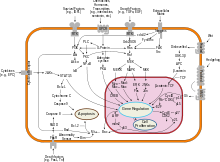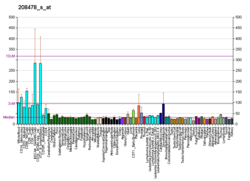BAX (タンパク質)
BAX(Bcl-2-associated X protein、Bcl-2結合Xタンパク質)は、ヒトではBAX遺伝子によってコードされるタンパク質で、アポトーシスの調節因子である。BCL2L4(Bcl-2-like protein 4)という名称でも知られる。Bcl-2ファミリーのメンバーはヘテロまたはホモ二量体を形成し、さまざまな細胞活性に関与してアポトーシスの促進または抑制を行う調節因子として機能する。このタンパク質はBCL2とヘテロ二量体を形成し、アポトーシス活性化因子として機能する。BAXはミトコンドリアの電位依存性アニオンチャネル(VDAC)と相互作用して開口を増加させ、膜電位の消失とシトクロムcの放出を引き起こすことが報告されている。この遺伝子の発現はがん抑制因子であるp53によって調節されており、p53を介したアポトーシスに関与することが示されている[5]。
構造
[編集]BAX遺伝子は、Bcl-2ファミリーのアポトーシス促進性のメンバーとして最初に同定された[6]。Bcl-2ファミリーのメンバーは、4つの特徴的なBcl-2相同(BH)ドメイン(BH1、BH2、BH3、BH4)を1つ以上共有しており、ヘテロ二量体またはホモ二量体を形成する[6][7]。これらのドメインは9つのαヘリックスからなり、疎水的なαヘリックスのコアを両親媒性のヘリックスが囲み、C末端のαヘリックスはミトコンドリア外膜に固定されている。α2のC末端からα5のN末端、そしてα8の一部の残基で形成される疎水的な溝に対し、活性型となった他のBAXやBcl-2分子のBH3ドメインが結合する。 α1とα6によって形成される小さな疎水的な溝がタンパク質の反対側に位置し、BAXの活性化部位として機能している可能性がある[8]。
BAX遺伝子のオルソログは、全ゲノム情報が利用可能な哺乳類のほとんどで同定されている[9]。
機能
[編集]健康な哺乳類細胞ではBAXの大部分は細胞質に存在するが、アポトーシスシグナル伝達の開始に伴って、BAXのコンフォメーションに変化が起こる。アポトーシスの誘導に伴って、BAXはオルガネラ、特にミトコンドリアの膜に結合するようになる[10][11][12][13][14]。
BAXはミトコンドリアの電位依存性アニオンチャネル(VDAC)と相互作用し、開口を誘導すると考えられている[15]。活性化されたBAXまたはBAKのオリゴマーがミトコンドリア外膜でMACと呼ばれる孔を形成することを示唆する証拠も蓄積している[16][17]。その結果、シトクロムcや他のアポトーシス促進因子がミトコンドリアから放出され(ミトコンドリア外膜透過化(mitochondrial outer membrane permeabilization)とも呼ばれる)、カスパーゼの活性化が引き起こされる[18]。BAXの活性化は、熱、過酸化水素、低いまたは高いpH、ミトコンドリア膜の再構成など、さまざまな生物的・非生物的因子によって促進される。さらに、Bcl-2やp53、Bif-1などのタンパク質への結合によっても活性化される。逆に、BAXはVDAC2、Pin1、IBRDC2との相互作用によって不活性化される[8]。
臨床的意義
[編集]BAXの発現はがん抑制因子p53によってアップレギュレーションされ、BAXはp53を介したアポトーシスに関与することが示されている。p53は転写因子であり、細胞のストレス応答の一部として活性化され、BAXを含む多くの下流標的遺伝子を調節する。野生型のp53は変異体p53と比較して、BAXのコンセンサスプロモーター配列を利用したレポータープラスミドの転写を約50倍活性化する。そのため、p53はin vivoでBAXのアポトーシス機能を促進する主要な転写因子である可能性が高い。p53には、アポトーシスに関して転写非依存的な役割も存在する。特に、p53はBAXと相互作用し、その活性化とミトコンドリア膜への挿入を促進する[19][20][21]。
BH3模倣薬であるABT-737など、BAXを活性化する薬剤は、がん細胞でアポトーシスを誘導する抗がん剤として期待される[8]。例えば、BADのBcl-xLへの結合と、それに伴うBAX:Bcl-xL間の相互作用の破壊は、卵巣がんのパクリタキセル抵抗性を部分的に改善することが示されている[22]。一方、虚血再灌流障害や筋萎縮性側索硬化症など過剰なアポトーシスが生じる状況では、BAXの阻害剤が有効である可能性がある[8]。
相互作用
[編集]
BAXは次に挙げる因子と相互作用することが示されている。
- Bcl-2[6][7][23][24][25]
- BCL2L1[7][22][26][27]
- BCL2A1[7][28]
- SH3GLB1[13][29]
- SLC25A4[30]
- VDAC1[15][18]
- TCTP[31]
- YWHAQ[32]
- BID[8]
- BCL2L11[8]
- PUMA[8]
- Noxa[8]
- MFN2[33]
- コレステロール[34]
- カルジオリピン[34]
出典
[編集]- ^ a b c GRCh38: Ensembl release 89: ENSG00000087088 - Ensembl, May 2017
- ^ a b c GRCm38: Ensembl release 89: ENSMUSG00000003873 - Ensembl, May 2017
- ^ Human PubMed Reference:
- ^ Mouse PubMed Reference:
- ^ “Entrez Gene: BCL2-associated X protein”. 2020年5月6日閲覧。
- ^ a b c “Bcl-2 heterodimerizes in vivo with a conserved homolog, Bax, that accelerates programmed cell death”. Cell 74 (4): 609–19. (August 1993). doi:10.1016/0092-8674(93)90509-O. PMID 8358790.
- ^ a b c d “Multiple Bcl-2 family members demonstrate selective dimerizations with Bax”. Proc. Natl. Acad. Sci. U.S.A. 92 (17): 7834–8. (August 1995). Bibcode: 1995PNAS...92.7834S. doi:10.1073/pnas.92.17.7834. PMC 41240. PMID 7644501.
- ^ a b c d e f g h Westphal, D; Kluck, RM; Dewson, G (February 2014). “Building blocks of the apoptotic pore: how Bax and Bak are activated and oligomerize during apoptosis.”. Cell Death & Differentiation 21 (2): 196–205. doi:10.1038/cdd.2013.139. PMC 3890949. PMID 24162660.
- ^ “ENSG00000087088_BAX”. www.orthomam.univ-montp2.fr. 2020年5月14日閲覧。
- ^ “Enforced dimerization of BAX results in its translocation, mitochondrial dysfunction and apoptosis”. EMBO J. 17 (14): 3878–85. (July 1998). doi:10.1093/emboj/17.14.3878. PMC 1170723. PMID 9670005.
- ^ “Cytosol-to-membrane redistribution of Bax and Bcl-X(L) during apoptosis”. Proc. Natl. Acad. Sci. U.S.A. 94 (8): 3668–72. (April 1997). Bibcode: 1997PNAS...94.3668H. doi:10.1073/pnas.94.8.3668. PMC 20498. PMID 9108035.
- ^ “Conformation of the Bax C-terminus regulates subcellular location and cell death”. EMBO J. 18 (9): 2330–41. (May 1999). doi:10.1093/emboj/18.9.2330. PMC 1171316. PMID 10228148.
- ^ a b “SH3GLB, a new endophilin-related protein family featuring an SH3 domain”. Genomics 71 (2): 222–34. (January 2001). doi:10.1006/geno.2000.6378. PMID 11161816.
- ^ “Movement of Bax from the cytosol to mitochondria during apoptosis”. J. Cell Biol. 139 (5): 1281–92. (December 1997). doi:10.1083/jcb.139.5.1281. PMC 2140220. PMID 9382873.
- ^ a b “Identification of the protein–protein contact site and interaction mode of human VDAC1 with Bcl-2 family proteins”. Biochem. Biophys. Res. Commun. 305 (4): 989–96. (June 2003). doi:10.1016/S0006-291X(03)00871-4. PMID 12767928.
- ^ Buytaert, E.; Callewaert, G.; Vandenheede, J. R.; Agostinis, P. (2006-07). “Deficiency in apoptotic effectors Bax and Bak reveals an autophagic cell death pathway initiated by photodamage to the endoplasmic reticulum”. Autophagy 2 (3): 238–240. doi:10.4161/auto.2730. ISSN 1554-8627. PMID 16874066.
- ^ McArthur, Kate; Whitehead, Lachlan W.; Heddleston, John M.; Li, Lucy; Padman, Benjamin S.; Oorschot, Viola; Geoghegan, Niall D.; Chappaz, Stephane et al. (22 February 2018). “BAK/BAX macropores facilitate mitochondrial herniation and mtDNA efflux during apoptosis”. Science 359 (6378): eaao6047. doi:10.1126/science.aao6047. PMID 29472455.
- ^ a b “Specific cleavage of Mcl-1 by caspase-3 in tumor necrosis factor-related apoptosis-inducing ligand (TRAIL)-induced apoptosis in Jurkat leukemia T cells”. J. Biol. Chem. 280 (11): 10491–500. (March 2005). doi:10.1074/jbc.M412819200. PMID 15637055.
- ^ “Tumor suppressor p53 is a regulator of bcl-2 and bax gene expression in vitro and in vivo”. Oncogene 9 (6): 1799–805. (June 1994). PMID 8183579.
- ^ “Immediate early up-regulation of bax expression by p53 but not TGF beta 1: a paradigm for distinct apoptotic pathways”. Oncogene 9 (6): 1791–8. (June 1994). PMID 8183578.
- ^ “Tumor suppressor p53 is a direct transcriptional activator of the human bax gene”. Cell 80 (2): 293–9. (January 1995). doi:10.1016/0092-8674(95)90412-3. PMID 7834749.
- ^ a b “BAD partly reverses paclitaxel resistance in human ovarian cancer cells”. Oncogene 17 (19): 2419–27. (November 1998). doi:10.1038/sj.onc.1202180. PMID 9824152.
- ^ Hoetelmans RW (2004). “Nuclear partners of Bcl-2: Bax and PML”. DNA Cell Biol. 23 (6): 351–4. doi:10.1089/104454904323145236. PMID 15231068.
- ^ “Conversion of Bcl-2 from protector to killer by interaction with nuclear orphan receptor Nur77/TR3”. Cell 116 (4): 527–40. (2004). doi:10.1016/S0092-8674(04)00162-X. PMID 14980220.
- ^ “Human homologue of S. pombe Rad9 interacts with BCL-2/BCL-xL and promotes apoptosis”. Nat. Cell Biol. 2 (1): 1–6. (2000). doi:10.1038/71316. PMID 10620799.
- ^ “Development of a high-throughput fluorescence polarization assay for Bcl-x(L)”. Anal. Biochem. 307 (1): 70–5. (2002). doi:10.1016/S0003-2697(02)00028-3. PMID 12137781.
- ^ “Induction of cell death by the BH3-only Bcl-2 homolog Nbk/Bik is mediated by an entirely Bax-dependent mitochondrial pathway”. EMBO J. 22 (14): 3580–90. (2003). doi:10.1093/emboj/cdg343. PMC 165613. PMID 12853473.
- ^ “Structural basis of BFL-1 for its interaction with BAX and its anti-apoptotic action in mammalian and yeast cells”. J. Biol. Chem. 275 (15): 11092–9. (2000). doi:10.1074/jbc.275.15.11092. PMID 10753914.
- ^ “Molecular cloning and characterization of Bif-1. A novel Src homology 3 domain-containing protein that associates with Bax”. J. Biol. Chem. 276 (23): 20559–65. (2001). doi:10.1074/jbc.M101527200. PMID 11259440.
- ^ “Bax and adenine nucleotide translocator cooperate in the mitochondrial control of apoptosis”. Science 281 (5385): 2027–31. (1998). Bibcode: 1998Sci...281.2027M. doi:10.1126/science.281.5385.2027. PMID 9748162.
- ^ Susini L (August 2008). “TCTP protects from apoptotic cell death by antagonizing bax function”. Cell Death Differ 15 (8): 1211–20. doi:10.1038/cdd.2008.18. PMID 18274553.
- ^ “14-3-3 Interacts directly with and negatively regulates pro-apoptotic Bax”. J. Biol. Chem. 278 (3): 2058–65. (2003). doi:10.1074/jbc.M207880200. PMID 12426317.
- ^ Hoppins, Suzanne; Edlich, Frank; Cleland, Megan M.; Banerjee, Soojay; McCaffery, J. Michael; Youle, Richard J.; Nunnari, Jodi (2011). “The Soluble Form of Bax Regulates Mitochondrial Fusion via MFN2 Homotypic Complexes”. Molecular Cell 41 (2): 150–160. doi:10.1016/j.molcel.2010.11.030. PMC 3072068. PMID 21255726.
- ^ a b Mignard, V; Lalier, L; Paris, F; Vallette, FM (29 May 2014). “Bioactive lipids and the control of Bax pro-apoptotic activity.”. Cell Death & Disease 5 (5): e1266. doi:10.1038/cddis.2014.226. PMC 4047880. PMID 24874738.
関連項目
[編集]外部リンク
[編集]- Human BAX genome location and BAX gene details page in the UCSC Genome Browser.







